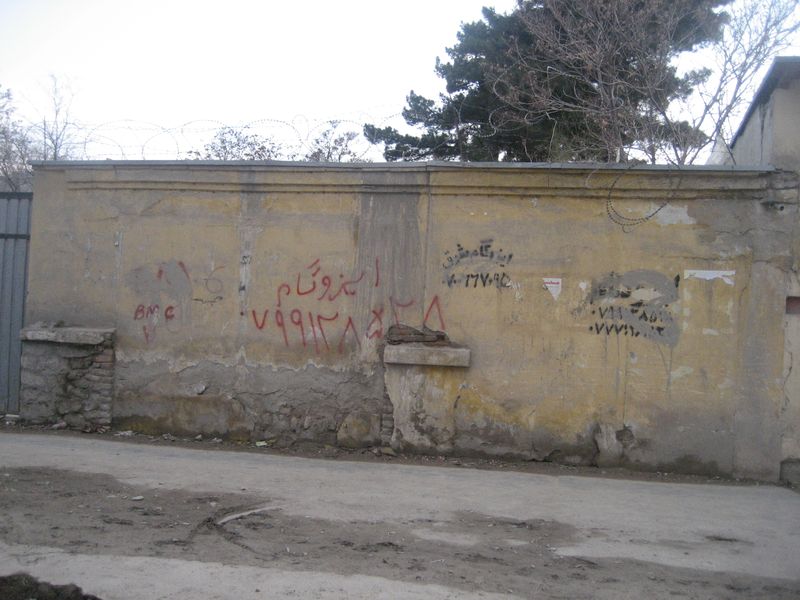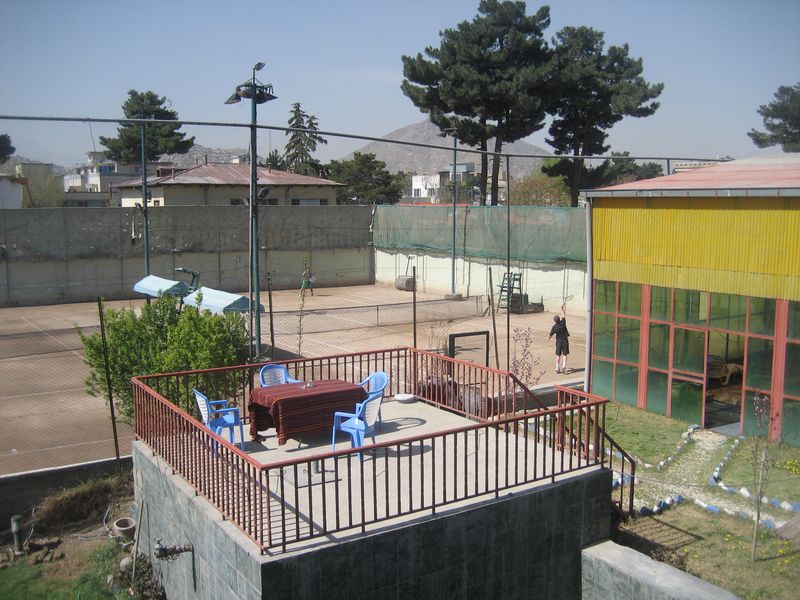By Humaira
Last week when I was in Kabul, I was staying in a guest house located in the Shar e Now (new city) district which used to be a very high-end neighborhood with paved roads, fancy shops. It was where foreigners would hang out along with wealthy modern Afghans. Today the only thing it has in common with its glorious past is that the foreigners are still there, only mostly congregating in offices, guest houses and restaurants, making the district one of the most dangerous in Kabul even though it's in the "green zone". The roads now have major pot holes, the sidewalks are crumbling, the traffic is unbearable and every building is draped in barbed wire and features a guard’s station with armed guards for protection.
My guest house, The International Club, had four guards outside the compound, and four inside. Every person who was not a guest was thoroughly searched, especially Afghans in traditional attire. In the sixties and seventies, the glory days of Afghanistan, The International Club was where the rich Afghans played tennis (the courts still there), swam in the indoor lap pool and gathered for networking and socializing. Sadly, today, the only Afghans allowed in were the waiters, cleaning staff and guards.
Another crumbling wall in share now
The fact that I, an Afghan, stayed there as a guest, brought a certain level of excitement to the hotel. All of the staff and the guards were particularly kind to me, going out of their way to be helpful. They were constantly trying to figure out if I am some kind of a celebrity or an influential person by shyly asking me subtle questions. The manager even refused to take my money when I tried to purchase a necklace from their stash of local handicrafts.
The International Club has an expansive menu featuring dozens of items -- smoothies, pizzas, pastas, and rice dishes – none of which ever seemed to be available when ordered. What surprised me most was that they had no Afghan food on the menu. I stand corrected, they did have Qabili Palau, but like most everything else, it was never available.
The of the tennis courts and the empty indoor pool from my room
To be honest with you of the nine days I was in Afghanistan I might have had Afghan food at a handful of meals. These were mostly in situations where we were invited as a guest of Governor, Mayor or a Minister at their offices. When I told my family members in Kabul about my cravings for Afghan food they showed up the next night at my guest house (which I couldn’t leave at nights) with a platter of Qabili Palau, sabzi (spinach), potato and green onion bolani (Afghan stuffed flat bread), a jar of dough (Afghan yogurt drink), aloo bukhara (dried sour plums) jam and a large platter of oranges for dessert.
The guards were blown away and so were all the other guests at the hotel. My 12 Afghan family members descending on the hotel loaded down with food was quite a sight. We had a big party in the hallway. The staff were very excited and kept bringing us tea, juice and pastries so I can be a good host to my guests. I was very grateful to my family and friends who came and visited me in my guesthouse when I was sequestered due to security issues and threats of riots.
So, in honor of Afghan hospitality, I am sharing the Qabili Palau recipe again since this was the dish that was served at every single Afghan meal I consumed. I must admit (and forgive me my dear friends who cooked for me while I was in Afghanistan) that my mom’s Qabili Palau is significantly more delicious and flavorful than any of the ones I had in Afghanistan. Let’s all make Qabili Palau in the next few days as a celebration of a peaceful Afghanistan where I can go visit my family members freely, day and night.
Qabili
Afghanistan’s National Dish
Qabili Palau
3 cups basmati rice
5 skinless chicken legs
5 skinless chicken thighs
2 large yellow onions, peeled and quartered
½ c plus 2 tbsp. olive oil or vegetable oil, divided
5 tsp. salt
1 cup chicken broth
3 large carrots, peeled
1 cup black raisins
½ cup slivered almonds
3 tbsp. sugar
¾ cup water
2 tsp. ground cumin
1 ½ tsp. ground cardamom
½ tsp. ground black pepper
12 cups water
2 tsp. browning sauce such at Kitchen Bouquet (optional)*
Instructions:
Preheat the oven to 500 degrees.
Immerse rice in a bowl of water and drain in a colander. Repeat this step 3 times.
Wash and dry the chicken. Set aside.
Chop the onions in a food processor using the pulse button. Don't puree the onions. You can do this by hand if you prefer.
Choose a sauté pan that is at least a couple inches deep and large enough to fit all the chicken. Pour ½ cup of the oil in the pan and sauté the onions over high heat, stirring quickly, until brown (5-10 minutes). Don't burn them. Add the chicken to the pan and sprinkle with 3 tsp. of the salt. Cook the chicken over medium-high heat for 6 minutes, turning from time to time so all sides turn golden brown. The onion will start to caramelize and turn into a thick sauce. Add 1/4 cup of the chicken broth, and continue stirring to keep the chicken from burning. Once the liquid has been absorbed, add another 1/4 cup of, bring it to a boil, cover with a lid or aluminum foil, and simmer for 10 minutes. The sauce should turn a dark brown. If your sauce does not take on a dark color you can add the Kitchen Bouquet to give it color.
While the chicken is cooking, cut the carrots into long matchsticks, about 4 inches long and 1/8-inch thick. Make sure that they are not too thin. In a large frying pan add ¾ cups of water and bring to a boil, add the carrots and cook until tender and a deep orange hue, 5 to 7 minutes. Keep a close eye on this to make sure you do not overcook them. Once the carrots are done, drain any leftover liquid out of the pan. Add the remaining 2 tbsp of oil, raisins, almonds and sugar to the carrots. Stir quickly over medium-high heat and keep stirring for about 3 minutes. The raisins will look plump; the carrots will take on a nice sweet flavor. Remove from heat and package the carrots into a sealed aluminum foil pouch about the size of a small paperback novel.
Remove the chicken pieces from the broth and set aside. Stir the cumin, cardamom and black pepper into the broth. Continue to cook on low for 5 minutes to allow it to thicken.
Meanwhile, measure 12 cups of water and the remaining 2 tsp. of salt into a large Dutch oven or pot (see our Palau post for photos) with a fitted lid. Bring it to a boil. Add the rice to the water and boil until it is al dente (nearly cooked, though still slightly crunchy). This will take just a few minutes depending on the rice you use. You will have to taste it to check for doneness. Do not overcook it.
Immediately strain the rice through a colander. Put the rice back into its cooking pot and add the broth. Mix well. Arrange the chicken pieces on top of the rice. Set the aluminum package of carrots on top of the rice. This will keep the carrots warm and deepen the flavors without mixing with the rice yet.
Bake the rice for 15 minutes in 500 degrees then drop the temperature down to 250 degrees. Cook for another 20 minutes.
Arrange the chicken pieces on a large platter, cover with the rice. Sprinkle the carrots, raisins, and almonds on the rice. Serve with a simple salad.
Serves 6-8
Except where otherwise noted, all content on this blog is licensed under the Creative Commons Attribution-NonCommercial-NoDerivs 3.0 Unported license.




